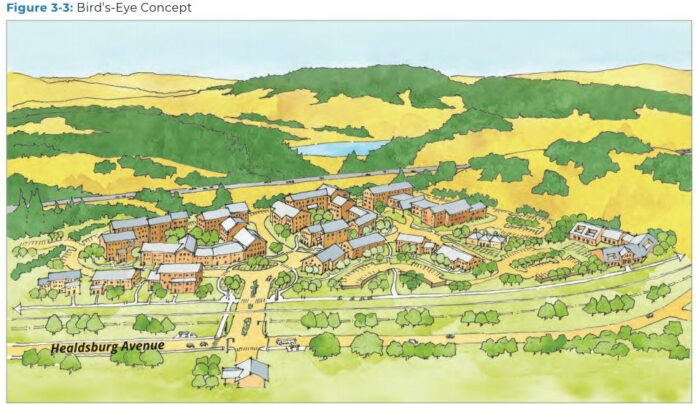Healdsburg City Council approved the North Entry Area Plan (NEAP) by a two 4-1 votes at its meeting May 20 at city hall.
Vice Mayor Leah Gold was the dissenting vote in both.
The votes amended both the Land Use Code and General Plan to allow for the NEAP.
The NEAP is a plan for 18 acres on the north end of town for mixed use development. The plan has a housing element that ranges from 250 units minimum to a 290 cap.
A 130-room limit has been set for a possible hotel, and if a hotel is built on the site, it would require 280 residential units be built.
There is also commercial space allotted for future development capped at 200,000 square feet.
The possibility of another hotel in town was the reason for Gold’s nay vote. She cited a community survey from 2018 that showed responders do not want to see another hotel. She further said the city does not have a responsibility to support a specific industry.
“Our residents have told us that they think this is too rapid expansion of our hotel capacity,” Gold said. “I know that there is a received wisdom that we cannot have a project that does not include a hotel. I do not accept that rationale.”
Councilmember Shaun McCaffery shared concerns on the size of the hotel, but ultimately voted for the NEAP with a hotel allowed, citing the increased mandate for housing if the hotel is proposed.
Councilmember Evelyn Mitchell countered Gold’s point by saying the survey also showed a desire to address affordable housing, which she said the NEAP does via its housing element and the city’s affordable housing requirement of 15%. (The Planning Commission has recommended raising that percentage to 20%, see the full story on page 6.)
Gold then asked if the 130-room limit could be lowered, though there was not consensus to do so.
Both Mayor David Hagele and Councilmember Joe Naujokas looked at the cap as a way to increase bargaining power when the plan becomes a defined project.
When a developer submits a project for the NEAP, the council also decided to require the process for approval to include a development agreement. This is the manner in which the Mill District project passed council, and was seen by all councilmembers as a solid process that increased the city’s voice in development.
During public comment, 10 people spoke. The comments were fairly evenly split for and against the project.
Concerns about the project mainly stemmed from the possibility of another hotel and the environmental impact the new hotel would have, particularly in terms of greenhouse gas emissions.
Resident Gail Jonas said it was the city’s duty to do its part to try and limit the amount of emissions caused by the possibility of international air travel to this destination.
A lawyer who spoke before her said it “looks like we’re going to court” should the NEAP pass.
Those in favor commended the city and particularly the Planning Commission for their work on the NEAP. The addition of housing was seen as a large plus.
There were concerns for those who thought the plan would pass as well.
Resident Tim Unger said that commercial space should be used to provide services that would reduce the need to travel by car, such as a small market or pharmacy.
McCaffery said he would like to see a market that is more substantial than a place to grab a sandwich to address both pollution and traffic concerns. He added that the market would help get grant money for future public land developments.
Staff reported that such a market would be limited to 6,000 square feet.
Resident Richard Burg stressed that the plan is just that, and should not be confused with a more detailed and concrete project as a developer has yet to submit one.
Though the majority of developable property on the NEAP site is owned by Comstock, they will not necessarily be the developer.
“We don’t know if we’ll be dealing with the same property owner when it hits the next stage,” Gold said.
Though council shared environmental concerns of the public, Naujokas and Hagele noted that the effort to reduce greenhouse gases and other pollutants should be a more regional effort.
“It’s really not fair to lay all that burden on the destination,” Naujokas said. “I think there’s all kind of movement at the regional level.”
Hagele said that “there is a lot that we’re doing locally” to go green.
In the city staff report, environmental impacts shared during community outreach were seen as speculative or were addressed through mitigation efforts.
The Environmental Impact Report (EIR) for the NEAP also passed 4-1, with Gold dissenting.
One possibility Naujokas suggested was that public transportation contributions could be rolled into the development agreement when the plan finds a project.
He noted that there is even the possibility of an automated shuttle to get downtown. This would lower emissions and would also be a possible component to address traffic, which he said was a concern but “we have plenty of room to mitigate those impacts.”
There were unavoidable traffic issues shown in the EIR. The immediate effect when development begins will be the addition of stop signs on Dry Creek Road at the Highway 101 interchange.
These will eventually be replaced by either a traffic signal or roundabout system, which will have a “fair share” contribution from the developer.
Another issue brought forth by Hagele concerned an evacuation plan. Fire Chief Jason Boaz said that though there is definitely a concern for getting people out in the event of a disaster like a wildfire, that issue applies to north Healdsburg in general and an emergency plan will be examined once a project is put forth for the NEAP.
The Foss Creek Pathway was also brought up, as it will divert from the creek toward Healdsburg Avenue at this point. Though it will have to be designed with both a future NEAP project and rail authority right of way in mind, staff said there should be room to create a multi-use wide path similar to what exists farther south.
Hagele also noted that the NEAP will be an opportunity to expand on local preference policy use.








